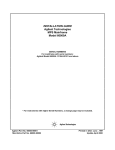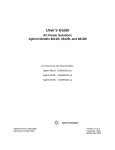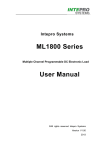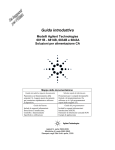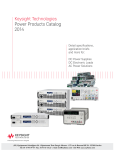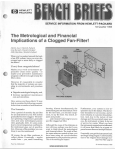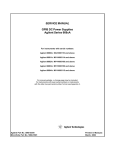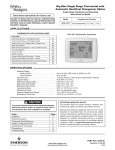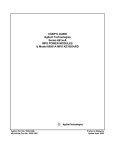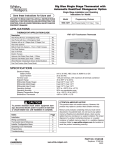Download Agilent Technologies 6626A Specifications
Transcript
10 Practical you need to tips know about your power products Simple ways to improve your operation and measurement capabilities Use Remote Sensing to Compensate for Load-Lead Effects Tip 1 I3 When your power supply leaves the factory, its regulation sense terminals are usually connected to the output terminals. This limits the supply’s voltage regulation abilities, even with very short leads. The longer the leads and the higher the wire gauge, the worse the regulation gets (Figure 1). Compare the output impedance of a well-regulated 10 A supply, which might have an output impedance of 0.2 mΩ, with the resistance of copper wire: + +S 5V Load 4.7 V –S – 0.015 Ω lead resistance Load leads are 6 foot, AWG 14 0.015 Ω lead resistance + 16.1 10.2 6.39 4.02 2.53 1.59 0.999 And regulation gets even worse if you use a relay to connect power to the load. Remote sensing, in which you connect the sense terminals of the power supply’s internal feedback amplifier directly to the load, lets the power supply regulate its output at the load terminals, rather than at its own output terminals (Figure 2). The supply voltage shifts as necessary to compensate for the resistance of the load leads, relays, or connectors, thereby keeping the voltage at the load constant. +S 5.3 V –S – I2 0.015 Ω lead resistance Load leads are 6 foot, AWG 14 Figure 2: Using remote sensing to correct the lead-load problem 2 22 20 18 16 14 12 10 To implement remote sensing, disconnect the local sense leads from the output terminals. Use twisted two-wire shielded cable to connect the power supply sensing terminals to the sense points on the load. (Don’t use the shield as one of the sensing conductors.) Connect one end of the shield to ground and leave the other end unconnected. Figure 1: The effects of six feet of AWG 14-gauge leads without remote sensing Power Supply Programmed for 5 V, 10 A Resistance in mΩ/ft (at 20° C) T3 0.015 Ω lead resistance Power Supply Programmed for 5 V, 10 A AWG wire size Load 5V Sensing currents are typically less than 10 mA, and as a general rule, you should keep the voltage drop in the sense leads to less than 20 times the power supply temperature coefficient (usually stated in mV/°C). This is easy to achieve with readily available shielded two-wire cable. Charge and Discharge Batteries in Less Time Tip 2 Using a power supply in constantcurrent mode (Figure 1) is a simple way to recharge batteries, and it also lets you achieve 100% charge levels. On the downside, this method is slow, taking as long as 14-16 hours because the charging current is only a fraction of the battery’s amp/hour rating. Pulse charging, also called transient mode, shortens the charging time, yet still charges the battery to over 90% capacity (Figure 2). The electronic load acts as a switch, providing the current pulses. (Note that you can also use an electronic load to program constant-current charging.) Figure 3 shows a typical pulse-charging current waveform. To simulate battery drain, you can also program the electronic load to discharge batteries with either constant or pulse current waveforms. In some cases, pulse discharging does a better job of mimicking a product’s energy-saving features. Simulating cellular phone battery discharge, for instance, is complex due to the phone’s various operating modes— standby, dialing, and talking. You can create the necessary tri-level discharge current wave-form shown in Figure 4 using the electronic load. I I2 I1 T Figure 1: Constant current charging is simple and effective, but it can be very slow. (The diode prevents the battery from discharging through the power supply if the supply voltage drops below the battery voltage.) I I2 T1 Figure 2: Pulse charging using an electronic load is much faster, while still achieving 90% recharge. T Figure 3: A typical pulse charging waveform created with an electronic load I1 T4 T3 T1 T2 T Figure 4: A complex waveform that simulates the energy-saving features in portable, battery-powered products 3 Tip 3 Increase Safety with Remote Disable Feature Remote disable offers a safe way to shut down a power supply to respond to some particular operating condition or to protect system operators (in response to a cabinet door being opened unexpectedly or someone pushing a panic button, for instance). Remote inhibit (RI) is an input to the power supply that disables the output when the RI terminal is pulled low (Figure 1). Shorting the normally open switch turns off the supply’s output. You could also use a logic chip with an open collector transistor output instead of the switch. Figure 1 also shows the discrete fault indicator (DFI), which you can use to signal an operator or other components in the system whenever the power supply detects a user-defined fault. Figure 1. Remote inhibit and discrete fault indicator schematic Figure 2. Daisy-chained DFI and RI 4 Almost any operating condition can create a DFI signal. For example, to generate a DFI signal when the load draws excessive current, enable the over current protection (OCP) mode, program the unit to generate a DFI signal when it enters constant current mode, then program the maximum current the load normally draws. If the load current exceeds the maximum, the DFI output goes low, disables the power supply, and informs the operator of the over-current condition (or performs another user-defined function), without tying up the system bus or interrupting the system controller. You can daisy chain DFI and RI as shown in Figure 2. If one supply detects a fault, all supplies in the system are disabled. Using this approach, you can chain together an unlimited number of supplies. Tip 4 Eliminate Noise from Low-Level Measurements Noise in low-level measurements can come from a number of different sources, and it’s easier to eliminate noise than to filter it. Check these noise sources: 1. Power Supply Starting with a low-noise supply is naturally a great way to keep noise out of your measurements. Linear power supplies have lower commonmode noise currents, and generally operate at low frequency. However, you can use switch-mode supplies successfully if their specifications include a low common-mode current. As a rule of thumb, common-mode current over 20-30 mA is likely to cause trouble. Keep reading for hints on how to minimize the problem. 2. DUT to Power Supply Connections Minimize conducted noise by eliminating ground loops. Ideally, there should be only one connection to ground. In rack systems, where multiple ground points are inevitable, separate the dc distribution path from other conductive paths that carry ground currents. If necessary, float the power supply (don’t connect either terminal directly to ground). Minimize radiated pick-up (both electric and magnetic) by using twisted shielded conductors for the output and remote sense leads. To make sure the shield doesn’t carry current, connect the shield to ground at one end only, preferably the single-point ground on the supply (Figure 1). Minimize the power supply’s commonmode noise current by equalizing the impedance to ground from the plus and minus output terminals. Also equalize the DUT’s impedance to ground from the plus and minus input terminals. Magnetic coupling or capacitive leakage provide a return path for noisy ground loop current at higher frequencies. To balance the DUT’s impedance to ground for your test frequencies, use a common-mode choke in series with the output leads and a shunt capacitor from each lead to ground. Figure 1: Minimizing radiated pick-up with twisted shield leads for both output and remote sense leads 3. Current Variations to the DUT Rapid changes in the DUT’s current demand cause voltage spikes. To prevent this, add a bypass capacitor close to the load. The capacitor should have a low impedance at the highest testing frequencies. Avoid imbalances in load lead inductance; direct connections to the DUT, such as twisted shielded pair, are your best bet. 5 Tip 5 Use Down Programming to Increase Test Speed Under light or no load conditions, a power supply’s output capacitor discharges slowly. If you’re using the supply as a static voltage source, this is not problematic, but when you’re making tests at varying voltage levels, slow discharge means slow tests. Down programming circuits in power supplies rapidly decrease the output voltage, reducing discharge times by hundreds of milliseconds. Agilent Technologies power supplies use two types of down programming circuits: Figure 1: A down programming circuit with an FET across the output terminals Figure 2: A down programmer situated between power supply’s positive output and a negative source 6 • In Figure 1, an FET is placed across the output terminals. Whenever the output voltage is higher than the programmed value, the FET activates and discharges the output capacitor. The FET can sink currents ranging from 10% to 20% of the supply’s output current rating. The maximum load at low voltages is limited to the On resistance of the FET plus the series monitoring resistor, resulting in a slight degradation of the down programming current near zero volts. • In Figure 2, the down programmer lies between the power supply’s positive terminal and a negative source. This configuration pulls the output completely down with no degradation near zero. Some power supplies, such as the Agilent 662xA and 663xB series, can sink currents equal to their full output current rating. In the 663xB series, this sink current is programmable, so you can use the supply both as a programmable source and load— very useful in applications such as charging and discharging batteries. Ensure Proper Power-up with Foldback Supplies Tip 6 Foldback power supplies protect connected equipment by reducing excess current (and thus output voltage) along a foldback path. When testing foldback power supplies using an electronic load, you need to take steps to be sure the power supply starts properly. Resistive Load R1 V R2 (R2 < R1) Foldback Region I Figure 1: Foldback behavior in constant resistance mode Constant Current Load I1 V P1 P2 When using an electronic load in constant resistance mode, the current increases as the resistance decreases, R1 to R2, until the current limit is reached; after that, the supply reduces its output current along the foldback path (Figure 1). To alleviate this problem, program the electronic load to a value below the current limit foldback point (Imin). This value can be close to zero on many supplies. After applying power to the source, increase the load’s current limit to the desired value. For power supplies that don’t require a minimum load current at all times, you can initially program the load in constant resistance mode. Then, when the power supply reaches its nominal operating voltage, switch the electronic load to constant current mode. (During the transition, the load momentarily goes to zero.) For constant current load, the power supply operates in constant voltage mode while the electronic load operates in constant current mode. When the power supply starts up, its output voltage is zero, and the electronic load tries to satisfy the programmed current value (I1) by decreasing the load resistance. The power supply interprets the low load value as an over-current condition, and immediately folds back to a stable operating point (P2 or P3 in Figure 2, depending on the power supply’s startup characteristics). Foldback Region P3 Imin I Figure 2: Foldback behavior for constant current load 7 R Tip 7 Connect Power Supplies in Series or Parallel for Higher Output Connecting two or more power supplies in series (Figure 1) provides higher voltages, but observe these precautions: Connecting two or more power supplies in parallel (Figure 2) provides higher currents, but again, observe these precautions: • Never exceed the floating voltage rating of any of the supplies. • Never subject any of the power supplies to negative voltages. • One unit must operate in constant voltage (CV) mode and the other(s) in constant current (CC) mode. • The output load must draw enough current to keep the CC unit(s) in CC mode. Program each power supply independently. If two supplies are used, program each one for 50% of the total output voltage. If three supplies are used, program each supply for about 33% of the total output voltage. Set the current limit of each supply to the maximum that the load can safely handle. Figure 1: Connecting units in series Figure 2: Connecting units in parallel 8 Program the current limit of each unit to its maximum value and program the output voltage of the CV unit to a value slightly lower than the CC unit(s). The CC units supply the maximum output current that they have been set to and drop their output voltage until it matches the voltage of the CV unit, which supplies only enough current to fulfill the total load demand. Tip 8 Use Your Power Supply to Measure Pulsed Current As a simpler and cheaper alternative, use a power supply with built-in measurement capabilities. The Agilent 66312A and 66332A dynamic measurement dc sources store up to 4,096 data points at sample intervals from 15.6 ms to 31,200 s. Like an oscilloscope, they acquire pre- and postYou could use an oscilloscope to mon- trigger buffer data by crossing a user-set threshold. These dynamic itor a shunt or a current probe, but this approach raises issues with volt- measurement capabilities are illustrated in an Agilent VEE program age drops, ground loops, common output panel (Figure 1). mode noise, space, and calibration. To adequately specify the power source for products that exhibit pulsed and dynamic current loading (such as digital cellular phones and hard drives), you need to evaluate both the peak and dc averages current draws. In Figure 2, note the SCPI commands in the “Set Up Source,” “Measure,” and “Enter Array” blocks. (You can use these commands in other programming environments as well.) Note that “MEAS” can be used in place of “FETC” to cause an immediate trigger. Obtain subsequent measurement parameters from the same data by using “FETC.” Figure 1. An Agilent VEE program that makes parametric measurements and captures the pulse current loading of a digital cellular phone Figure 2. Block flow diagram of the Agilent VEE program, showing program details 9 Tip 9 Characterize Inrush Current with an AC Power Source/Analyzer The inrush current characteristics of ac-dc switch mode power supplies vary with the turn-on phase of the voltage cycle. Usually, these power supplies have input capacitors that draw high peaks of inrush current as they charge from the rectified ac line at turn-on. Characterizing inrush current versus turn-on phase can provide some important design insights: Output Voltage Start up phase of 40 degrees Bus Trigger Inrush Current Peak Current Measurement Digitized Inrush Current Data Points Figure 1: An inrush current measurement at 40° using Agilent 6800 series ac power source/analyzers 10 • Uncover component stresses • Check to see if a product produces ac mains disturbances that interact with other products connected to the same branch circuit • Select proper fuses and circuit breakers However, this can be a challenging measurement because you have to synchronize the current digitization and peak current measurement with the startup phase of the voltage. Worst case inrush currents occur near the voltage cycle’s peak and when the ac input capacitor of the DUT is fully discharged at startup. Therefore, you must perform tests at incremental voltage startup phases from around 40° to 90° (Figure 1) and let the DUT’s ac input capacitor discharge between tests. A traditional test setup includes an ac source with programmable phase capability and an output trigger port, a digital oscilloscope, and a current probe. However, using an advanced ac power source/analyzer such as the Agilent 6800 series ac power source/analyzers is easier because they have built-in generation, current waveform digitization, peak current measurement, and synchronization capabilities that let you perform inrush current characterization without cabling and synchronizing separate instruments. Tip 10 Use a Power Supply to Measure DUT Supply Current Accurately measuring DUT supply currents above 10 A is beyond the range of the typical DMM in ammeter mode. You could use an external shunt and the DMM’s voltage mode, but using the power supply itself is a better solution. Many supplies include an accurate measurement system, including a shunt. Using the power source’s shunt to take current or voltage measurements at the DUT can be as simple as sending a MEAS command. The following table shows the level of measurement accuracy you can expect with a good-quality supply: Output level Typical accuracy Full 10% of full output 1% of full output 0.1% to 0.5% 0.5% to 1% near 10% While the advantages of using the power source to measure high currents is clear, using it to measure low currents may not be as obvious. A system DMM has 0.01% to 0.1% accuracy, although this doesn’t include other possible errors that can affect the measurement, such as cabling. In contrast, the power supply accuracy figures in the table include all applicable factors. A good system DMM can measure current down to the picoamp level, but you rarely need to measure DUT supply currents this low. In most cases, the toughest measurement will involve current draw by a batterypowered device in sleep mode (such as a cellular phone), where measuring 1-10 mA with reasonable accuracy is usually all you need. Most power supplies’ current readback performs well between full scale and 10% of full scale. Newer power sources, such as the Agilent 66000A modular power system, offer full scale accuracy of 0.06% at 16 A and 3.8% accuracy at 160 mA. You can also choose a power supply with multiple range readback. The 663XA series can measure as low as 2.5 µA and offers accuracy of 5.1% at 50 µA (with full-scale accuracy of 0.2%). Also, keep in mind that while ac sources offer many current measurement options, including rms, newer dc sources, such as the 66312A and 66332A, provide rms peak measurements as well (see Tip 8). 11 Power products that do more and less demand Agilent Technologies’ “one-box” philosophy means we pack more and more capability into the power products themselves, in some cases giving you a rack’s worth of capability in a single box. By offering more, these products demand less from you—fewer instruments, less rack space, simpler test setups, and lower cost of ownership. Dynamic measurement dc supplies Solar array simulator Autoranging dc supplies The Agilent 66312A and 66332A are the first power supplies with instantaneous peak measurement capability, so you no longer need a scope or high-speed digital voltmeter to test devices that draw pulsed current. The Agilent E4350A solar array simulator mimics the output characteristics of a satellite’s solar panels. It’s also a great example of our ability to create unique power solutions to meet unique application challenges. The Agilent 6030-series autoranging supplies are a flexible, convenient solution when you need to test a wide range of devices with a single supply or test devices with a variety of operating points. • Precision current measurement—as low as 0.6 µA • Dynamic voltage measurements accurate to 0.03% + 5 mV • Dynamic current measurements accurate to 0.6% + 1 mA (66312A) • Simulate I-V curves of a solar array under various conditions • Operate the system in three different modes for maximum flexibility • Available as individual power modules or as a turnkey system customized to your needs • Choose from six models with power ratings from 200 W to 1 kW • All models offer Agilent’s one-box solution with built-in readback • Current ranges from 2 to 120 A; voltage ranges from 6.7 to 500 V Dynamic measurement dc supplies Model Voltage Current Maximum power 66312A 66332A 0 to 20 V 0 to 2 A 40W 0 to 20 V 0 to 5 A 100W Solar array simulator Model Voltage Current Maximum power E4350A 0 to 60 V 0 to 8 A 450W Auto-ranging supplies Model 6033A 6038A 6030A 6031A 6032A 6035A Voltage Current Maximum output power at any valid combination of V and I 0 to 20 V 0 to 30 A 0 to 60 V 0 to 10 A 0 to 200 V 0 to 17 A 0 to 20 V 0 to 120 A 0 to 60 V 0 to 50 A 0 to 500 V 0 to 5 A 200 W 200 W 1000 W 1000 W 1000 W 1000 W 12 Power you can count on year after year We’ve been a leader in the power products business for more than three decades because engineers like you know they can count on Agilent performance, reliability and value. Even our least-expensive dc supplies offer low ripple and noise with tight load and line regulation. Our highprecision products give you the exact power levels you need, with accurate readback measurements to match. Plus, every product you see here is covered by a three-year warranty. Single-output dc supplies These supplies will clean up your ATE power without cleaning out your budget. Not only do you buy more performance with the Agilent 6600series, their one-box integration means you’ll buy less equipment overall, too. To learn more about these power solutions, please use the reply card or visit our Web site at www.agilent.com/find/power. For immediate service, call one of the engineers at Agilent at 800-4524844. • Clean, reliable dc power from 40 W to 5 kW • Designed for fast, easy system integration • Built-in V & I readback for one-box convenience Single-output dc supplies 40 W and 100 W Voltage Current 200 W Output voltage Output current (40° C) Maximum current (50° C) Maximum current (55° C) 500 W Output voltage Ouput current (40° C) Maximum current (50° C) Maximum current (55° C) 2 kW Output voltage Output current 5 kW Voltage Current (derated linearly 1%/° C to 55° C) * Economy versions with identical specifications, but without GPIB. 6612B 6632B 6633B 6634B 0 to 20 V 0 to 2 A 0 to 20 V 0 to 5 A 0 to 50 V 0 to 2 A 0 to 100 V 0 to 1 A 6541A* 6641A 6542A* 6642A 6543A* 6643A 6544A* 6644A 6545A* 6645A 0 to 8 V 0 to 20 A 18.0 A 17.0 A 0 to 20 V 0 to 10 A 9.0 A 8.5 A 0 to 35 V 0 to 6 A 5.4 A 5.1 A 0 to 60 V 0 to 3.5 A 3.2 A 3.0 A 0 to 120 V 0 to 1.5 A 1.4 A 1.3 A 6551A* 6651A 6552A* 6652A 6553A* 6653A 6554A* 6654A 6555A* 6655A 0 to 8 V 0 to 50 A 45.0 A 42.5 A 0 to 20 V 0 to 25 A 22.5 A 21.3 A 0 to 35 V 0 to 15 A 13.5 A 12.8 A 0 to 60 V 0 to 9 A 8.1 A 7.7 A 0 to 120 V 0 to 4 A 3.6 A 3.4 A 6571A* 6671A 6572A* 6672A 6573A* 6673A 6574A* 6674A 6575A* 6675A 0 to 8 V 0 to 220 A 0 to 20 V 0 to 100 A 0 to 35 V 0 to 60 A 0 to 60 V 0 to 35 A 0 to 120 V 0 to 18 A 6680A 6681A 6682A 6683A 6684A 0 to 5 V 0 to 8 V 0 to 21 V 0 to 32 V 0 to 40 V 0 to 875 A 0 to 580 A 0 to 240 A 0 to 160 A 0 to 128 A 13 Power products that do more and demand less Multiple-output dc supplies Modular power system Electronic Loads The Agilent 6620-series’ multiple outputs and integrated I & V readback dramatically simplify the job of system integration and maintenance. Plus, the 6625A, 6626A, 6628A and 6629A models offer the precision of 14-bit dual range programming and readback. With rack space at a premium, the Agilent 66000 modular power system’s growing popularity is no surprise. A single mainframe can hold up to eight modules, and you can choose from six modules with voltage ranges up to 200 V and current ranges up to 16 A. Agilent’s integrated electronic loads help you save time, money, and rack space while delivering precise control and all the capabilities you need for analyzing dc power sources and devices. Use the programable pulse waveform generator or use analog programming to simulate real-life load conditions. • Choose 2, 3, or 4 independent, isolated outputs • Precision programming and readback • Built-in readback for one-box convenience and value • High power density—up to eight supplies in seven inches of rack space • Low noise, stable power • High accuracy programming and readback • Ideal for evaluating dc power sources and power components • Lower costs while improving ease of use and test quality • Single-input and modular units with proven record of reliability Multiple-output dc supplies Model 40-W output Low-range volts, amps 0 to 7 V, 0 to 5 A High-range volts, amps 0 to 20 V, 0 to 2 A Output combinations for each model (total number of outputs) 6621A (2) — 6622A (2) — 6623A (3) 1 6624A (4) 2 6627A (4) — 40-W output 0 to 20 V, 0 to 2 A 0 to 50 V, 0 to 0.8 A 80-W output 0 to 7 V, 0 to 10 A 0 to 20 V, 0 to 4 A 80-W output 0 to 20 V, 0 to 4 A 0 to 50 V, 0 to 2A — — 1 2 4 2 — 1 — — — 2 — — — High range 0 to 50 V 0 to 500 mA Low range 0 to 16 V 0 to 200 mA Precision multiple-output supplies Model Output power 25-W output Output range Low range Output volts 0 to 7 V Output amps 0 to 15 mA Output combinations for each model (total number of outputs) 6625A (2) 6626A (4) 6628A (2) 6629A (4) 50-W output 1 2 0 0 High range 0 to 50 V or 0 to 16 V 0 to 1 A or 0 to 2 A 1 2 2 4 Modular power systems Model Output ratings at 40° C Output voltage Output current Maximum power 66101A 66102A 66103A 66104A 66105A 66106A 0 to 8 V 0 to 16 A 128 W 0 to 20 V 0 to 7.5 A 150 W 0 to 35 V 0 to 4.5 A 157.5 W 0 to 60 V 0 to 2.5 A 150 W 0 to 120 V 0 to 1.25 A 150 W 0 to 200 V 0 to 0.75 A 150 W 6060B, 60502B 3-60 V 300 W 6063B, 60503B 3-240 V 250 W 60501B 3-60 V 150 W 60504B 3-150 V 600W 60507 3-150 V 500 W Electronic Loads Model Input voltage Maximum power 14 AC power source/analyzers From avionics to uninterruptible power supplies, customers are demanding products that can use power efficiently while handling all kinds of ac line disturbances. To make sure your products meet these growing expectations, test them with the Agilent 6800-series ac power source/analyzers. • The fast, easy way to generate both clean and distorted ac power for product testing • A complete solution in a single, compact, tightly integrated box with graphical user interface • Built-in 16-bit power analyzer precisely measures all important parameters Harmonic/flicker test systems The Agilent 6840-series harmonic/ flicker test systems transform an expensive headache into a competitive advantage. Instead of sending prototypes out to a test lab and waiting for the results, you can now afford to do your own compliance testing—whenever and wherever you need. • Compliance-level testing of IEC low-frequency emission standards • An inexpensive, integrated solution that is easier to install, use, and maintain • Advanced diagnostics go beyond simple pass/fail to help you modify designs quickly We’ve combined a precision ac source with built-in power analysis, flickermeter, complete testing and reporting software, and our in-depth knowledge of the IEC standards. The result is much less expensive and easier to maintain than traditional testers built from separate instruments. The 6840 test system is easy to set up and the graphical software is easy to use, so you don’t need to be a compliance expert to get dependable results. You’ll have both real-time and off-line data analysis and review, plus report generation and data archiving for thorough test documentation. AC Power Source/analyzers Model Max power # of phases 6811A 6812A 6813A 6814B 6834B 375 VA 1 750 VA 1 1750 VA 1 3000 VA 1 4500 VA 1/3 6841A 6842A 6843A 750 VA 1 1750 VA 1 4800 VA 1 Harmonic flicker test systems Model Max power # of phases For more information, please use the reply card inside, visit our Web site at www.agilent.com/find/power, or call Agilent at 800-452-4844. 15 You’re trying to get the most from your power products and get the best power products for your money—-and this booklet is a great place to start. You’ll find 10 easy and practical ways to improve power generation and measurement, along with a brief look at our most popular power instruments and systems. For more information, please use the reply card inside, visit our website at www.agilent.com/find/power, or call Agilent at 800-452-4844. Agilent Technologies’ Test and Measurement Support, Services, and Assistance Agilent Technologies aims to maximize the value you receive, while minimizing your risk and problems. We strive to ensure that you get the test and measurement capabilities you paid for and obtain the support you need. Our extensive support resources and services can help you choose the right Agilent products for your applications and apply them successfully. Every instrument and system we sell has a global warranty. Support is available for at least five years beyond the production life of the product. Two concepts underlie Agilent’s overall support policy: “Our Promise” and “Your Advantage.” Our Promise “Our Promise” means your Agilent test and measurement equipment will meet its advertised performance and functionality. When you are choosing new equipment, we will help you with product information, including realistic performance specifications and practical recommendations from experienced test engineers. When you use Agilent equipment, we can verify that it works properly, help with product operation, and provide basic measurement assistance for the use of specified capabilities, at no extra cost upon request. Many self-help tools are available. Your Advantage “Your Advantage” means that Agilent offers a wide range of additional expert test and measurement services, which you can purchase according to your unique technical and business needs. Solve problems efficiently and gain a competitive edge by contracting with us for calibration, extracost upgrades, out-of-warranty repairs, and on-site education and training, as well as design, system integration, project management, and other professional services. Experienced Agilent engineers and technicians worldwide can help you maximize your productivity, optimize the return on investment of your Agilent instruments and systems, and obtain dependable measurement accuracy for the life of those products. Get assistance with all your test and measurement needs at: www.agilent.com/find/assist Product specifications and descriptions in this document subject to change without notice. Copyright © 1997, 2000 Agilent Technologies Printed in U.S.A. 8/00 5965-8239E
















